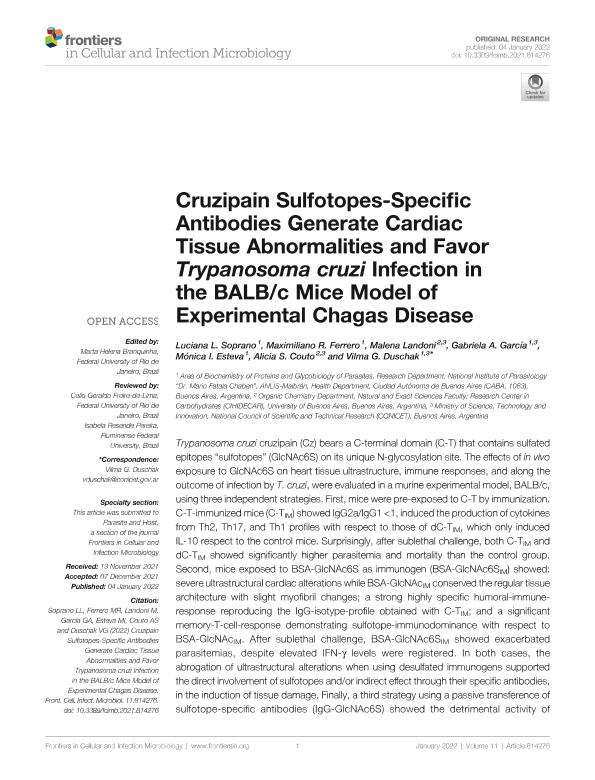Artículo
Cruzipain Sulfotopes-Specific Antibodies Generate Cardiac Tissue Abnormalities and Favor Trypanosoma cruzi Infection in the BALB/c Mice Model of Experimental Chagas Disease
Soprano, Luciana Lía ; Ferrero, Maximiliano Ruben
; Ferrero, Maximiliano Ruben ; Landoni, Malena
; Landoni, Malena ; García, Gabriela Analía; Esteva, Mónica Inés; Couto, Alicia Susana
; García, Gabriela Analía; Esteva, Mónica Inés; Couto, Alicia Susana ; Duschak, Vilma Gladys
; Duschak, Vilma Gladys
 ; Ferrero, Maximiliano Ruben
; Ferrero, Maximiliano Ruben ; Landoni, Malena
; Landoni, Malena ; García, Gabriela Analía; Esteva, Mónica Inés; Couto, Alicia Susana
; García, Gabriela Analía; Esteva, Mónica Inés; Couto, Alicia Susana ; Duschak, Vilma Gladys
; Duschak, Vilma Gladys
Fecha de publicación:
01/2022
Editorial:
Frontiers Media
Revista:
Frontiers in Cellular and Infection Microbiology
ISSN:
2235-2988
Idioma:
Inglés
Tipo de recurso:
Artículo publicado
Clasificación temática:
Resumen
Trypanosoma cruzi cruzipain (Cz) bears a C-terminal domain (C-T) that contains sulfated epitopes “sulfotopes” (GlcNAc6S) on its unique N-glycosylation site. The effects of in vivo exposure to GlcNAc6S on heart tissue ultrastructure, immune responses, and along the outcome of infection by T. cruzi, were evaluated in a murine experimental model, BALB/c, using three independent strategies. First, mice were pre-exposed to C-T by immunization. C-T-immunized mice (C-TIM) showed IgG2a/IgG1 <1, induced the production of cytokines from Th2, Th17, and Th1 profiles with respect to those of dC-TIM, which only induced IL-10 respect to the control mice. Surprisingly, after sublethal challenge, both C-TIM and dC-TIM showed significantly higher parasitemia and mortality than the control group. Second, mice exposed to BSA-GlcNAc6S as immunogen (BSA-GlcNAc6SIM) showed: severe ultrastructural cardiac alterations while BSA-GlcNAcIM conserved the regular tissue architecture with slight myofibril changes; a strong highly specific humoral-immune-response reproducing the IgG-isotype-profile obtained with C-TIM; and a significant memory-T-cell-response demonstrating sulfotope-immunodominance with respect to BSA-GlcNAcIM. After sublethal challenge, BSA-GlcNAc6SIM showed exacerbated parasitemias, despite elevated IFN-γ levels were registered. In both cases, the abrogation of ultrastructural alterations when using desulfated immunogens supported the direct involvement of sulfotopes and/or indirect effect through their specific antibodies, in the induction of tissue damage. Finally, a third strategy using a passive transference of sulfotope-specific antibodies (IgG-GlcNAc6S) showed the detrimental activity of IgG-GlcNAc6S on mice cardiac tissue, and mice treated with IgG-GlcNAc6S after a sublethal dose of T. cruzi, surprisingly reached higher parasitemias than control groups. These findings confirmed the indirect role of the sulfotopes, via their IgG-GlcNAc6S, both in the immunopathogenicity as well as favoring T. cruzi infection.
Archivos asociados
Licencia
Identificadores
Colecciones
Articulos(CIHIDECAR)
Articulos de CENTRO DE INVESTIGACIONES EN HIDRATOS DE CARBONO
Articulos de CENTRO DE INVESTIGACIONES EN HIDRATOS DE CARBONO
Articulos(SEDE CENTRAL)
Articulos de SEDE CENTRAL
Articulos de SEDE CENTRAL
Citación
Soprano, Luciana Lía; Ferrero, Maximiliano Ruben; Landoni, Malena; García, Gabriela Analía; Esteva, Mónica Inés; et al.; Cruzipain Sulfotopes-Specific Antibodies Generate Cardiac Tissue Abnormalities and Favor Trypanosoma cruzi Infection in the BALB/c Mice Model of Experimental Chagas Disease; Frontiers Media; Frontiers in Cellular and Infection Microbiology; 11; 1-2022; 1-22
Compartir
Altmétricas



